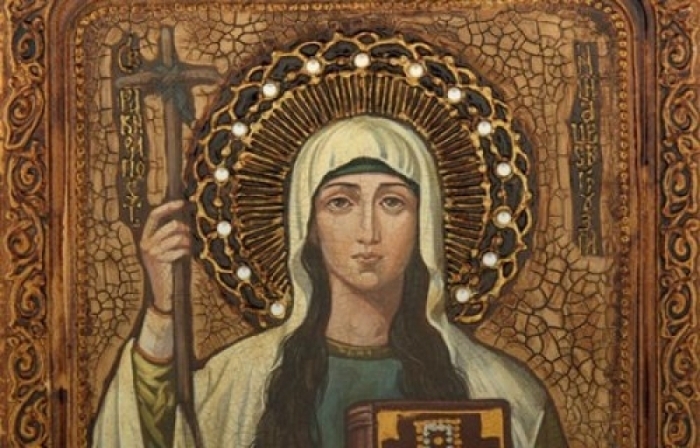Georgia celebrates the holiday of Ninooba, dedicated to the country's Christian patron Saint, Saint Nino

The Orthodox Church of Georgia today, on January 27, celebrates the day of the blessed death of the Holy enlightener of Georgia, equal to the Apostles Nino – the feast of Ninooba.
In Georgia, Saint Nino is especially revered and considered a Christian patroness. She became famous for preaching the gospel and converting the inhabitants of Iberia to the Christian faith. In 326, Christianity in ancient Georgia became the state religion thanks to the sermons of the Holy Nino of equal to the apostles. On the occasion Ninooba in all Orthodox churches of Georgia, the solemn worship. After the Liturgy in Tbilisi, in the Cathedral of the assumption of the blessed virgin Mary – Sioni, parishioners can touch the Holy cross of St. Nino, woven from a vine.
According to legend, it was with this cross that Saint Nino preached and persuaded king Mirian III of Iberia and Queen Nana to convert to the Christian faith. The form of the so-called "cross of Saint Nino" - with a horizontal crossbar curved like a vine-is considered canonical along with other forms of the cross accepted in Orthodoxy.
Saint Nino is commemorated twice a year with festive services in Georgia: on January 27, the day of her death, and on June 1, the day of her coming. In 2019, the Georgian Orthodox Church celebrated the 1700th anniversary of the Saint's coming.
Today, the name day of everyone who bears the name Nino is one of the most common female names in Georgia. The name Nina, which is quite popular all over the world, also comes from Georgia. According to the state services development Agency of the Ministry of justice of Georgia, this name is used by about 118 thousand women.
The historical fact is that in 325, the Byzantine Emperor Constantine, at the request of king Mirian, sent clerics to Iberia, led by a Bishop, to baptize the king, his family, and his people. This is considered the year of the establishment of Christianity in Georgia.
In the same period, under Saint Nino, the construction of the Svetitskhoveli temple was started in the capital city of Mtskheta, where, according to legend, the Chiton of Christ, brought to Georgia by local Jewish Christians, rests.
According to Church and historical records, Saint Nino was born in about 280 in Cappadocia and fled from the oppression of the Emperor Diocletian.
In the ancient capital of Iberia — Mtskheta, a Christian preacher came in 320, fleeing from oppression in Armenia. Saint Nino passed the Paravan lake, then the Borjomi gorge and the Gori upland-modern pilgrims repeat this route several times a year.
In Mtskheta, Saint Nino settled in the Tsar's garden, under a BlackBerry Bush — today, the Samtavro temple stands on this site. At that time, paganism flourished in Georgia, Uplistsikhe was considered a sacred city, and an idol to the pagan deity Armazi was installed near Mtskheta, in Bagineti.
It is believed that Saint Nino lived for about 67 years and was buried in the village of Bodbe in Kakheti, near the city of Sighnaghi. The Cathedral of the patron Saint of Georgia — George the victorious and Nino — a three-nave Basilica of the IX century was built over the Saint's grave. Currently, the Church has the largest female monastery in Georgia.
newsgeorgia.ge
Tags:
Georgia celebrates the holiday of Ninooba, dedicated to the country's Christian patron Saint, Saint Nino

The Orthodox Church of Georgia today, on January 27, celebrates the day of the blessed death of the Holy enlightener of Georgia, equal to the Apostles Nino – the feast of Ninooba.
In Georgia, Saint Nino is especially revered and considered a Christian patroness. She became famous for preaching the gospel and converting the inhabitants of Iberia to the Christian faith. In 326, Christianity in ancient Georgia became the state religion thanks to the sermons of the Holy Nino of equal to the apostles. On the occasion Ninooba in all Orthodox churches of Georgia, the solemn worship. After the Liturgy in Tbilisi, in the Cathedral of the assumption of the blessed virgin Mary – Sioni, parishioners can touch the Holy cross of St. Nino, woven from a vine.
According to legend, it was with this cross that Saint Nino preached and persuaded king Mirian III of Iberia and Queen Nana to convert to the Christian faith. The form of the so-called "cross of Saint Nino" - with a horizontal crossbar curved like a vine-is considered canonical along with other forms of the cross accepted in Orthodoxy.
Saint Nino is commemorated twice a year with festive services in Georgia: on January 27, the day of her death, and on June 1, the day of her coming. In 2019, the Georgian Orthodox Church celebrated the 1700th anniversary of the Saint's coming.
Today, the name day of everyone who bears the name Nino is one of the most common female names in Georgia. The name Nina, which is quite popular all over the world, also comes from Georgia. According to the state services development Agency of the Ministry of justice of Georgia, this name is used by about 118 thousand women.
The historical fact is that in 325, the Byzantine Emperor Constantine, at the request of king Mirian, sent clerics to Iberia, led by a Bishop, to baptize the king, his family, and his people. This is considered the year of the establishment of Christianity in Georgia.
In the same period, under Saint Nino, the construction of the Svetitskhoveli temple was started in the capital city of Mtskheta, where, according to legend, the Chiton of Christ, brought to Georgia by local Jewish Christians, rests.
According to Church and historical records, Saint Nino was born in about 280 in Cappadocia and fled from the oppression of the Emperor Diocletian.
In the ancient capital of Iberia — Mtskheta, a Christian preacher came in 320, fleeing from oppression in Armenia. Saint Nino passed the Paravan lake, then the Borjomi gorge and the Gori upland-modern pilgrims repeat this route several times a year.
In Mtskheta, Saint Nino settled in the Tsar's garden, under a BlackBerry Bush — today, the Samtavro temple stands on this site. At that time, paganism flourished in Georgia, Uplistsikhe was considered a sacred city, and an idol to the pagan deity Armazi was installed near Mtskheta, in Bagineti.
It is believed that Saint Nino lived for about 67 years and was buried in the village of Bodbe in Kakheti, near the city of Sighnaghi. The Cathedral of the patron Saint of Georgia — George the victorious and Nino — a three-nave Basilica of the IX century was built over the Saint's grave. Currently, the Church has the largest female monastery in Georgia.
newsgeorgia.ge
Tags:


























